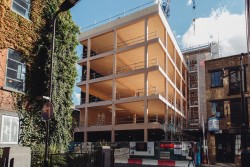Laminated veneer lumber (LVL) is becoming a more familiar feature of timber-based construction. Peter Wilson, architect and founding director of the Mass Timber Academy explains more.
Like glulam, LVL is formed from layers of wood in which the grain in every layer runs in the same di-rection. Unlike glulam, however, LVL's layers are only 3mm thick and are produced by putting a long blade against a rotating log to peel a continuous veneer that is subsequently glued and pressed into boards or beams. There are two advantages to this over CLT or glulam – the resulting LVL products have significantly greater strength than their two mass timber siblings, plus they make far more effi-cient use of the raw timber.
Over the next few years, LVL demand in Europe is forecast to have a projected average annual growth rate of 6+%. This substantial LVL consumption increase will likely be driven in the main by several key factors, including growing LVL usage rates and volumes in domestic house construction both as beams and headers as well as I-Joist flanges – builders' needs to shorten building erection times, to avoid expensive on-site equipment and to reduce the cost of on-site labour. This base level demand will undoubtedly benefit from greater awareness amongst architects and engineers of LVL's properties and benefits and its consequent use in larger commercial and public projects.
Amongst these benefits are the continuing advances being made in peeling and lamination technology that allow manufacturers to produce lighter and smaller LVL sections with a greater strength and longer span than sawn timber. As wood defects have been removed and randomised within thin lay-ers, LVL is stronger, straighter, and more uniform than traditional sawn timber. The phenomenon of shrinkage and swelling is hugely reduced, making for more dimensionally stable and accurate con-struction. Due to its composite nature and pre-graded veneers for stiffness, LVL is also much less likely to warp, twist or bow than tradition timber.
But why the emphasis on the use of hardwood as opposed to softwood LVL? Essentially this product has massive structural strength benefits compared to softwood glulam and delivers a more highly effi-cient yield from the log its veneers are sourced from than is possible in the manufacture of CLT and glulam. Because it can be produced in long sheets as well as beam and column form, its potential to be curved and twisted in two directions at once offers considerable design potential to conceive and construct building forms never previously possible with wood.
Some readers may not be aware of LVL projects in the UK, but there are some remarkable examples, not least the five-storey Black & White Building currently being completed in London's Shoreditch area that is attracting considerable attention from commercial developers. Its prefabricated beech hardwood LVL post and beam structure supports a CLT core and slabs, but the apparent simplicity of this fully-engineered, precision-built timber construction belies its groundbreaking innovation.
Sitting on a very tight site and erected at remarkable speed with no major plant and with practically no noise and no waste, its optimisation of material delivers a powerful sustainable agenda with only 410 kgCO2e/m2 embodied carbon (A1-A5).
The opportunities available with LVL lie not only in the creation of new building forms, but in LVL's potential to for designers to rethink and reshape the way in which we build out towns and cities. Two of the world's leading LVL manufacturers are busily exploring these possibilities: Metsä Wood and Stora Enso are not only talking the talk, but they are also walking the walk, the latter constructing its 'Wood City' in Helsinki, the largest sustainable urban wooded district in Finland and a demonstration to the wider world of the efficiency and high quality that can be achieved with LVL.
For more information visit: www.masstimberacademy.com
Read the full article, go to Offsite Magazine








